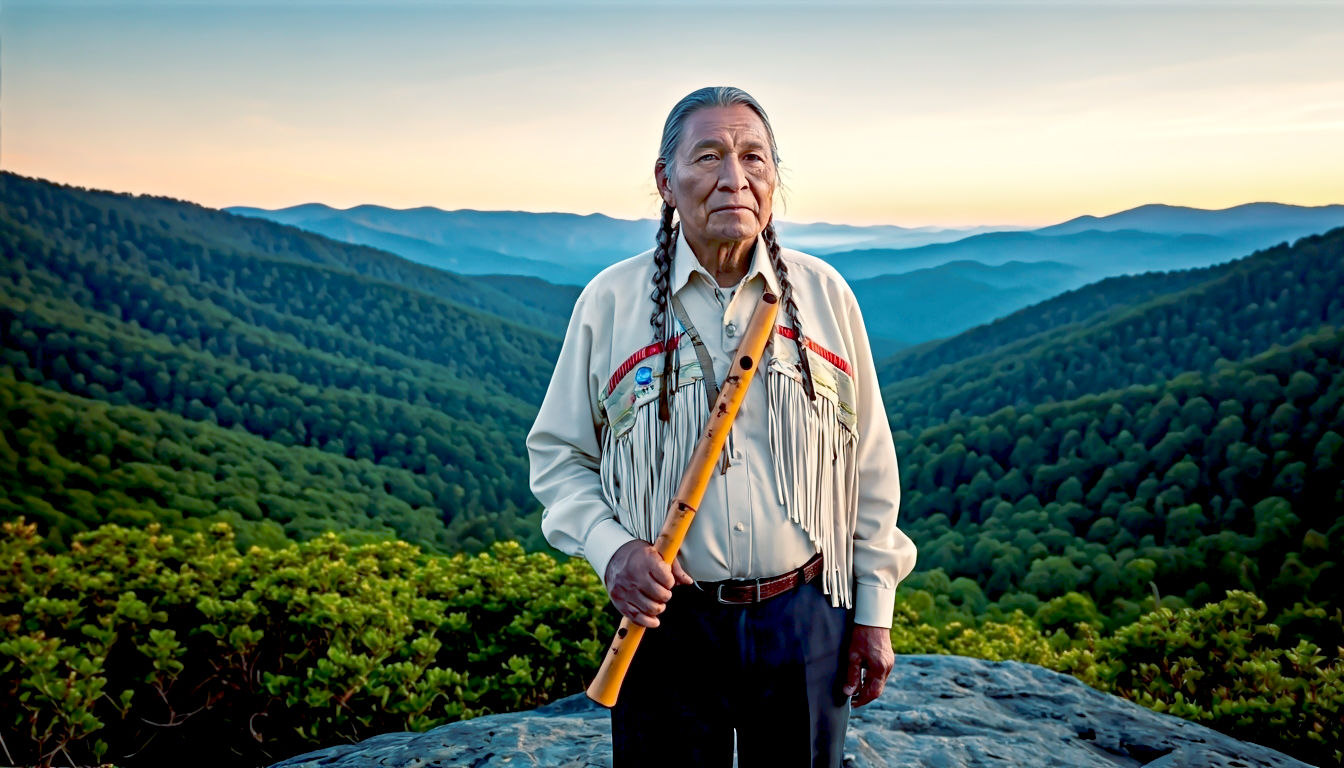A Journey Through the Old North State: The Story of North Carolina’s Native American Reservations
Explore the story of the Eastern Band of Cherokee Indians, from the Trail of Tears to their modern, sovereign nation in the mountains of North Carolina.

This post may contain affiliate links. If you make a purchase through these links, we may earn a commission at no additional cost to you.
Imagine a history stretching back thousands of years, long before the first European ships even dreamed of crossing the Atlantic. This isn’t some far-flung tale; it’s the story of North Carolina, a place where ancient cultures have left an indelible mark on the landscape. For many of us here in Britain, our picture of America is often shaped by films and television—cowboys, skyscrapers, and vast, empty deserts. But the real story, especially in a state like North Carolina, is far richer and more complex.
At the heart of this story are the Native American tribes and their ancestral lands. You might have heard the term “reservation” before, but what does it really mean? It’s not just a piece of land on a map. It’s a place of community, of sovereignty, and of a history that’s been fought for, lost, and reclaimed over centuries.
In this guide, we’re going to take a journey through the history of North Carolina’s Native American reservations. We’ll explore who the original inhabitants were, what happened when European settlers arrived, and how one tribe, the Eastern Band of Cherokee Indians, managed to hold onto their homeland in the misty Appalachian Mountains. It’s a story of resilience, of cultural survival, and of a unique relationship between a sovereign nation and the United States government. Forget what you think you know about American history—this is the story from the ground up, and it’s a fascinating one.
The Lay of the Land: What Exactly is a Reservation?
Before we dive into the history, let’s get our heads around the big question: what is a Native American reservation? It’s a term we hear a lot, but the details can be a bit fuzzy.
Think of it like this: a reservation is an area of land that is managed by a federally recognised Native American tribe, rather than the state government it sits within. This concept is a bit like the Crown Dependencies—say, the Isle of Man or Jersey. They are self-governing and have their own laws and governments, but they still have a special relationship with the United Kingdom.
In the same way, a Native American reservation operates under a system of tribal sovereignty. This means the tribe has the authority to govern itself, make its own laws, have its own police force and court system, and manage its own schools and health services. This is a crucial point. It’s not just land owned by a group of people; it’s a nation within a nation.
This status comes from treaties and agreements made between the tribes and the United States government hundreds of years ago. Of course, the history of these treaties is often complicated and painful, filled with broken promises. But the principle of sovereignty remains the bedrock of what a reservation is today.
North Carolina’s Unique Situation
Now, here’s where North Carolina stands out. Unlike states in the American West, which are famous for their large, sprawling reservations, North Carolina has only one federally recognised reservation. This is the Qualla Boundary, home to the Eastern Band of Cherokee Indians (EBCI).
You might be wondering why there’s only one. The answer lies in a dramatic and tragic chapter of American history that we’ll explore in detail later on: the Trail of Tears. While many Cherokee were forcibly removed from their lands and marched west, a small group managed to stay behind, clinging to their ancestral home in the mountains. The Qualla Boundary is the land they and their descendants fought to keep.
There are other state-recognised tribes in North Carolina, like the Lumbee, who have a powerful presence and a rich culture, but they don’t have the same federally recognised reservation status. This distinction between federal and state recognition is really important, as it affects a tribe’s legal rights and its relationship with the U.S. government.
So, as we go forward, remember this: the story of reservations in North Carolina is really the story of the Eastern Band of Cherokee Indians and their remarkable fight for their homeland.
Before the Ships Arrived: North Carolina’s First Peoples
To truly understand the story of the Qualla Boundary, we need to wind the clock back—way back. For at least 12,000 years before the first European settlers arrived, North Carolina was home to a vibrant tapestry of different Native American cultures.
These weren’t just a few scattered groups. The area was bustling with distinct peoples, each with their own languages, traditions, and territories. Archaeologists have found evidence of their lives everywhere, from ancient tools and pottery fragments buried beneath the soil to the great earthen mounds that still rise from the landscape.
Three major language groups dominated the region:
- Iroquoian: This group included the Cherokee, who controlled the mountainous western part of the state, and the Tuscarora in the east. The Cherokee were the largest and most powerful tribe in the area.
- Siouan: Tribes like the Catawba, Waxhaw, and Saura lived in the central Piedmont region. They were skilled hunters and farmers.
- Algonquian: Along the coast, tribes like the Chowanoke, Pamlico, and Croatan thrived on the rich resources of the sea and sounds. They were among the first to encounter English explorers.
The World of the Cherokee
The Cherokee, or Aniyvwiya (“Principal People”) as they call themselves, had a sophisticated society. They lived in settled towns, often built along rivers, with homes made from a plaster-like mixture of clay and grass over a wooden frame.
Their society was organised around clans—think of them as large, extended families. Clan identity was passed down through the mother, a system known as matrilineal descent. This meant that women held a great deal of power and influence. They owned the houses and the fields, and the children belonged to the mother’s clan.
Each town had its own council and chiefs. A “White” chief would lead during times of peace, while a “Red” chief took charge during war. This structure allowed for a balance of power and diplomacy. They were not a single, unified empire, but rather a confederacy of towns that shared a common language and culture.
Their lives were deeply connected to the land. They were skilled farmers, cultivating the “Three Sisters”—corn, beans, and squash—which grew together in a way that supported each other. They hunted deer, bear, and turkey in the vast forests and fished in the clear mountain streams. Their understanding of the natural world was profound, woven into their stories, ceremonies, and daily lives.
This was the world that existed for millennia—a stable, complex society in perfect balance with its environment. It was this world that was about to be turned upside down. The arrival of European settlers in the 16th and 17th centuries would set in motion a chain of events that would change North Carolina forever and push the Cherokee to the brink of extinction.
A Clash of Worlds: European Settlement and its Aftermath
When the first European settlers began to arrive in North Carolina, they didn’t find an empty wilderness. They found a land that was owned, managed, and understood by the people who had lived there for centuries. The collision of these two worlds—one driven by a thirst for land and resources, the other rooted in a deep, ancestral connection to that same land—was destined to be fraught with conflict.
The relationship wasn’t always hostile at first. In the early days, there was trade. The native peoples offered deerskins and furs, which were highly prized in Europe, in exchange for things like metal tools, guns, and cloth. This trade created new alliances but also new rivalries between tribes.
But the settlers brought more than just goods. They brought diseases like smallpox and measles, to which the Native Americans had no immunity. Epidemics swept through villages, wiping out entire communities. It’s estimated that in some areas, as much as 90% of the native population died from these new diseases. It was a biological catastrophe that shattered their societies before the worst of the land conflicts even began.
The Insatiable Hunger for Land
As the European population grew, so did their demand for land. The British colonists, in particular, saw the vast, fertile lands of North Carolina as something to be owned, divided up, and farmed for profit. This idea of private land ownership was completely alien to the Cherokee and other tribes. For them, land wasn’t a commodity; it was a shared resource, the source of life itself, something you belonged to rather than something that belonged to you.
This fundamental misunderstanding was the source of endless conflict. Treaties were signed, but they were often negotiated under duress or through translators who didn’t fully grasp the concepts being discussed. The settlers would agree to a boundary, only for new waves of colonists to push past it, clearing forests and starting farms on tribal hunting grounds.
Wars erupted, like the Tuscarora War (1711-1715) and the Yamasee War (1715-1717). The tribes fought bravely to defend their homes, but they were outmatched by the colonists’ numbers and superior weaponry. These conflicts almost always ended with the tribes being forced to give up more and more of their land.
The American Revolution: A Fateful Choice
When the American colonies declared their independence from Great Britain in 1776, the tribes faced a difficult choice. Who should they side with? Most, including a large portion of the Cherokee, chose to ally with the British. This wasn’t because of a deep love for the Crown, but because the British government had tried to put some limits on colonial expansion. A Royal Proclamation in 1763 had forbidden settlement west of the Appalachian Mountains. The tribes hoped that a British victory would help protect their lands from the ever-encroaching American settlers.
Unfortunately, they backed the losing side. When the Americans won the war, they saw the tribes who had sided with the British as conquered enemies. The pressure for land intensified, and the new United States government began a systematic policy of forcing tribes to sign away their remaining territories.
This was the grim reality facing the Cherokee at the dawn of the 19th century. They had lost millions of acres. Their world was shrinking, and the very survival of their people was at stake. But they were not defeated. Instead, they would try a new strategy: to adapt, to modernise, and to prove that they could coexist with their new neighbours. It was a bold experiment that would end in one of the darkest chapters in American history.
The Trail of Tears: A Nation Forcibly Removed
In the early 1800s, the Cherokee Nation made a remarkable effort to adapt to the changing world. They saw what was happening around them and decided that the best way to protect their sovereignty and their land was to adopt some of the customs of the white settlers. This period is often called the “Cherokee Renaissance.”
They created a formal government with a written constitution, modelled on that of the United States. They established a capital city at New Echota in Georgia. A brilliant Cherokee scholar named Sequoyah invented a written alphabet, or syllabary, for the Cherokee language. For the first time, they could read and write in their own tongue. They even started their own newspaper, the Cherokee Phoenix. They built schools and successful farms and businesses.
By any measure, they were a thriving, “civilised” nation. They had done everything the U.S. government had asked of them. Surely, they thought, this would be enough to secure their rights and their homeland.
They were wrong.
Gold, Greed, and the Indian Removal Act
Two things happened that sealed the Cherokee’s fate. First, gold was discovered on their land in Georgia in 1828. This triggered a frantic gold rush, and thousands of white prospectors flooded into Cherokee territory, ignoring their laws and their rights.
Second, a new president, Andrew Jackson, was elected. Jackson was a populist and a former Indian fighter who had built his career on opening up native lands for white settlement. He had no interest in honouring treaties and saw the tribes as an obstacle to be removed.
In 1830, Jackson pushed the Indian Removal Act through Congress. This law gave the federal government the power to force the Native American tribes living in the southeastern United States to move to a designated “Indian Territory” west of the Mississippi River (what is now Oklahoma).
The Cherokee didn’t give up without a fight. They took their case to the highest court in the land, the U.S. Supreme Court. In a landmark case, Worcester v. Georgia (1832), the court actually sided with the Cherokee. Chief Justice John Marshall wrote that the Cherokee Nation was a sovereign entity and that the laws of Georgia had no force within its territory.
It was a stunning legal victory, but it meant nothing. President Jackson famously defied the court, reportedly saying, “John Marshall has made his decision; now let him enforce it.” The state of Georgia, with the full backing of the president, ignored the ruling and continued to seize Cherokee land.
The Forced March
A small, unauthorised group of Cherokee, known as the “Treaty Party,” signed a removal treaty without the consent of the vast majority of the tribe. This gave the U.S. government the excuse it needed.
In 1838, the U.S. army was sent into the Cherokee Nation. Under the command of General Winfield Scott, soldiers rounded up about 16,000 Cherokee men, women, and children at bayonet point. They were forced from their homes with little more than the clothes on their backs and herded into squalid stockades.
Then, they were forced to march more than 1,000 miles west during the brutal autumn and winter. The conditions were horrific. There was not enough food, water, or warm clothing. Disease, especially cholera and dysentery, ran rampant. People grew weak and died along the side of the road.
This forced march is known as the Trail of Tears. It is a name that barely captures the scale of the suffering. Of the 16,000 Cherokee who were forced to leave, more than 4,000 died on the journey. They were buried in unmarked graves far from their ancestral home. It was an act of ethnic cleansing, a brutal and deliberate policy to remove a people from their land.
But not every Cherokee was forced west. A small number managed to escape the roundup, hiding in the dense forests and caves of the Great Smoky Mountains. Their story is one of incredible courage and determination, and it is the reason why there is a reservation in North Carolina today.
The Birth of the Qualla Boundary: A Homeland Reclaimed
While the tragedy of the Trail of Tears was unfolding, a small group of Cherokee managed to defy the U.S. government’s removal policy. Their story is the key to understanding how the Eastern Band of Cherokee Indians and the Qualla Boundary came to be.
This group, numbering around 1,000, was led by a man named Tsali. When soldiers came to his family’s home, they resisted, and one of the soldiers was killed. Tsali and his family fled into the mountains. The army, struggling to find all the Cherokee hiding in the rugged terrain, made a deal. If Tsali and his sons surrendered to be executed, the other Cherokee hiding in the mountains would be allowed to stay. In an ultimate act of sacrifice, Tsali agreed. His martyrdom helped secure a future for his people in their homeland.
Another crucial figure was William Holland Thomas. Thomas was a white man who had been adopted into the Cherokee tribe as a boy. He became a successful businessman and a lawyer and used his own money and his legal skills to help the Cherokee. He acted as their agent, buying back tracts of their ancestral land in his own name, because at the time, it was illegal for Native Americans to own land.
Piecing Together a Nation
The land Thomas bought formed the nucleus of what would become the Qualla Boundary. It wasn’t a single, neat block of land like a traditional reservation created by a treaty. Instead, it was a patchwork of different parcels, totalling about 57,000 acres, scattered throughout Western North Carolina.
For decades, the legal status of this group, who became known as the Eastern Band of Cherokee Indians, was uncertain. They weren’t part of the Cherokee Nation in Oklahoma, but they also weren’t considered full citizens of the United States. They lived in a kind of legal limbo.
Finally, in 1868, the U.S. government formally recognised the EBCI as a distinct tribe. And in 1876, the lands that William Thomas had bought were placed in a federal trust for the tribe. This is the official birth of the Qualla Boundary as a reservation.
What is the Qualla Boundary?
It’s important to be clear: the Qualla Boundary is not a reservation in the same way as many in the western U.S. It is a “deed-held” territory. The land is owned by the tribe but held in trust by the federal government. The residents own their homes but not the land underneath them, which is held in common for all tribal members.
Today, the Qualla Boundary covers a little over 56,000 acres next to the Great Smoky Mountains National Park. The main town and administrative centre is Cherokee, North Carolina. It’s a place where the tribe’s past and present meet. You can see ancient traditions being kept alive, but it’s also a modern community with its own government, schools, hospital, and a thriving economy.
The creation of the Qualla Boundary was not an act of generosity by the U.S. government. It was the result of the Cherokee’s own incredible resilience, the sacrifice of people like Tsali, and the clever, dedicated work of allies like William Holland Thomas. It stands as a powerful testament to a people who refused to be erased from their land.
Life on the Qualla Boundary Today: A Sovereign Nation
Step into the Qualla Boundary today, and you’re entering a sovereign nation. The Eastern Band of Cherokee Indians has its own government, its own laws, and a vibrant culture that blends ancient traditions with modern life. It’s a community of over 16,000 enrolled members, with about 10,000 living on the Boundary itself.
Government and Sovereignty
The EBCI government is structured much like the U.S. government, with three branches:
- Executive Branch: Headed by a Principal Chief and a Vice Chief, who are elected every four years. They act as the head of state, overseeing the day-to-day operations of the tribe.
- Legislative Branch: The Tribal Council is made up of 12 members who represent the different townships within the Qualla Boundary. They are responsible for making the laws.
- Judicial Branch: The tribe has its own court system, the Cherokee Court, which handles most civil and criminal cases that occur on tribal land.
This self-governance is the heart of what it means to be a sovereign nation. The tribe manages its own affairs, from education and healthcare to law enforcement and economic development, all tailored to the specific needs and values of the Cherokee people.
Economic Engine: Gaming and Tourism
For many years, the tribe struggled with poverty and lack of opportunity. That all changed dramatically in the 1990s. In 1988, the U.S. passed the Indian Gaming Regulatory Act, which confirmed the right of federally recognised tribes to operate casinos on their land.
The EBCI saw this as a powerful opportunity for economic self-sufficiency. In 1997, they opened Harrah’s Cherokee Casino Resort. It was an instant success. The casino has since expanded multiple times and is now a massive resort with hotels, restaurants, a concert venue, and a world-class spa. They later opened a second casino, the Harrah’s Cherokee Valley River Casino & Hotel.
The impact of gaming has been transformative. The revenue generated from the casinos funds the entire tribal government and all its services—schools, healthcare, emergency services, and infrastructure. It has virtually eliminated unemployment on the Boundary and created thousands of jobs, not just for tribal members but for people throughout Western North Carolina.
A unique feature of the EBCI’s system is the per capita distribution. A portion of the casino profits is paid out directly to every enrolled member of the tribe twice a year. This has provided a direct economic boost to thousands of families.
Tourism is the other major pillar of the economy. Visitors come from all over the world to learn about Cherokee history and culture, to see the stunning mountain scenery, and to enjoy outdoor activities like fishing and hiking. Attractions like the Oconaluftee Indian Village (a living history museum) and the outdoor drama “Unto These Hills” provide authentic cultural experiences while also creating jobs.
Keeping the Culture Alive
While the economy has modernised, the tribe has worked hard to preserve and revitalise its culture. The Cherokee language is a key focus. It’s a difficult language to learn, and the number of fluent speakers had been dwindling for years. Now, there are language immersion schools where children are taught entirely in Cherokee from a young age. This is a vital effort to ensure the language survives for future generations.
Traditional arts and crafts are also thriving. The Qualla Arts and Crafts Mutual is a cooperative that promotes authentic Cherokee crafts like basket weaving, pottery, beadwork, and carving. It ensures that these ancient skills are passed down and provides a marketplace for artists to sell their work.
From the annual Cherokee Indian Fair in the autumn to the stickball games played with fierce intensity, the culture is alive and well. It’s not something frozen in a museum; it’s a living, breathing part of daily life. The people of the Eastern Band have shown that it’s possible to embrace economic progress while holding fast to the traditions that define who they are.
Looking to the Future: Challenges and Triumphs
The story of the Eastern Band of Cherokee Indians and the Qualla Boundary is one of remarkable success. From the ashes of the Trail of Tears, they have built a prosperous, self-sufficient nation. But like any community, they face challenges as they look to the future.
One of the biggest issues is balancing economic development with cultural preservation. The success of the casino has brought immense benefits, but it has also brought rapid change. Some worry about the impact of commercialism on their traditions and the natural environment. The tribe is constantly navigating how to grow its economy in a way that is sustainable and respects their cultural values.
Healthcare is another key area. Like many rural communities in America, they face challenges with access to care and issues like diabetes and substance abuse. However, because they control their own healthcare system, they can create programs that are culturally sensitive and tailored to the needs of their people. For example, they have integrated traditional foods and wellness practices into their health programs.
Education is a major priority. The tribe runs its own school system, which allows them to incorporate Cherokee language and culture into the curriculum every day. This helps give young people a strong sense of their identity. They have also invested heavily in higher education, providing scholarships for tribal members to attend university.
A Legacy of Resilience
The ultimate story of North Carolina’s only reservation is one of resilience. It’s the story of a people who survived a forced removal, who held onto their homeland against all odds, and who have built a modern, thriving nation on their own terms.
They have demonstrated that tribal sovereignty is not just a historical concept; it’s a living, working model for self-determination. They are using their economic success to reclaim their language, strengthen their culture, and provide for their people.
For us in Britain, it’s a powerful reminder that the history of America is not a single, simple story. It is a complex mosaic of different cultures, of painful conflicts, and of inspiring survival. The Eastern Band of Cherokee Indians are not a relic of the past. They are a vital part of North Carolina’s present and a powerful force shaping its future. Their journey from the brink of annihilation to a sovereign, prosperous nation is one of the most compelling, and often overlooked, stories in American history.
Further Reading & Resources
For those interested in delving deeper into the rich history and culture of the Eastern Band of Cherokee Indians and other Native American tribes, here are some highly respected resources:
- The Official Website of the Eastern Band of Cherokee Indians: The primary source for information on the tribe’s government, services, and current events.
- The Museum of the Cherokee Indian: An award-winning museum located in Cherokee, NC, offering incredible insight into 11,000 years of Cherokee history and culture.
- The National Museum of the American Indian (Smithsonian): A comprehensive resource for the history and culture of all Native peoples of the Western Hemisphere.
- UNC American Indian Center: A centre at the University of North Carolina at Chapel Hill dedicated to research, education, and service for Native communities in the state.






